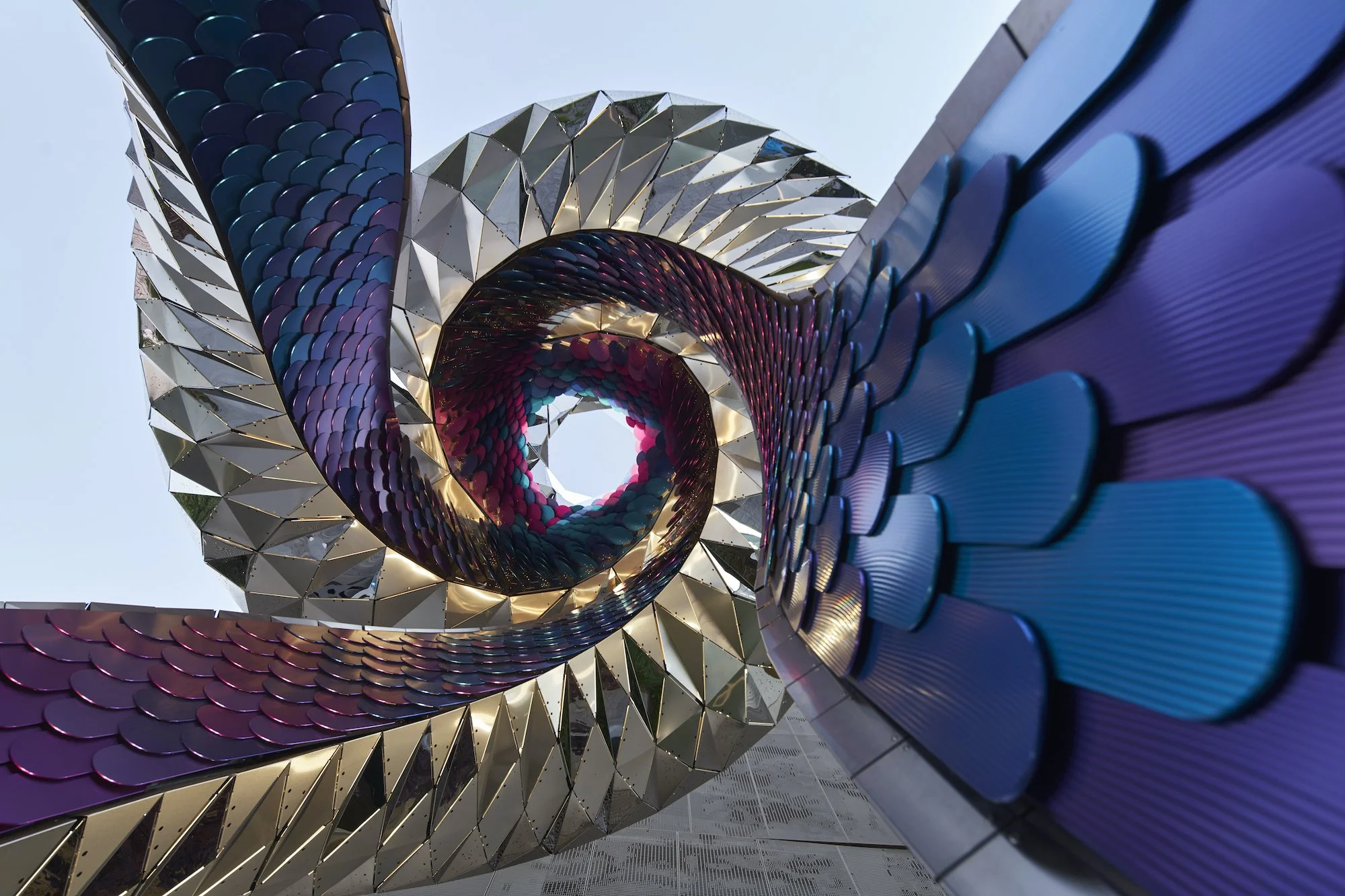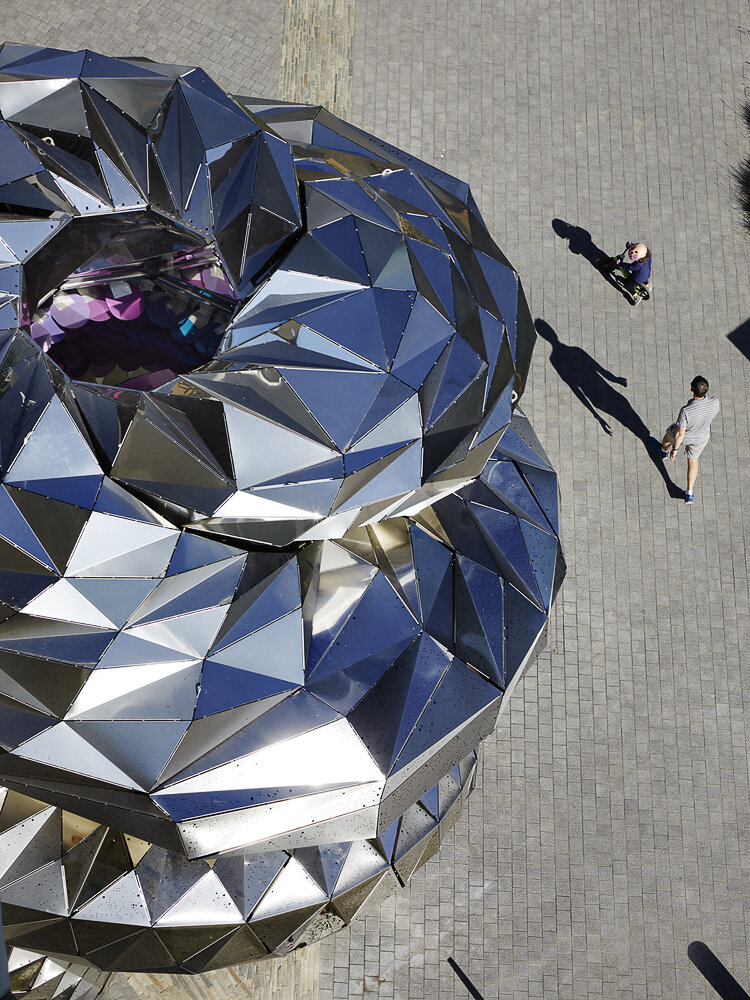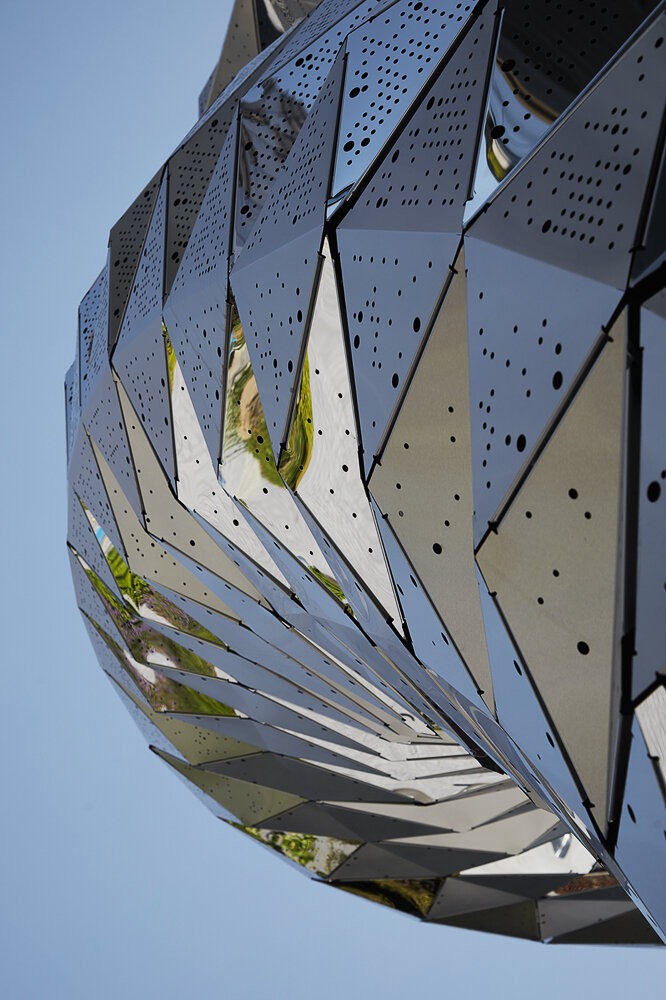How can we use art to convey optimism for the future while ensuring it engages and activates the public sphere?
Orbital is a contemporary garden folly, exploring geometric and material exuberance. It evokes organic forms found in nature, but also giant robots and futuristic space vehicles. The structure is composed of three coiled legs that spiral towards the sky. The exterior surface is defined by stainless steel origami skins, while the interior space is wrapped by a vortex of colorful tactile shingles. Orbital’s dynamic form evokes an era of rapid change and uncertainty, while also inspiring curiosity and playful interaction.
Location: Mission Bay, San Francisco, CA (Pierpoint Lane and Bridgeview Way - Map)
Dimensions: 24’ x 24’ x 33.3’ Tall
Materials: Stainless steel, aluminum
Lead Artists: Jason Kelly Johnson & Nataly Gattegno (Futureforms)
Artist Team: Jason Kelly Johnson, Nataly Gattegno with Carlos Sabogal, Brian McKinney, Clayton Williams, Natalie Abbott, Chris Leo, Valerie Tse; assisted by Lee Marom, Ki Schmidt, Sam Higgwe | Structural Engineer: Arup (Nick Sherrow-Groves, Lead) | Fabrication Team: Futureforms (San Francisco, CA), Olson Steel (San Leandro, CA), Seaport Stainless (Richmond, CA), Standard Sheet Metal; Skin installers: Pacific Erectors, Sheedy Crane Co.; Aluminum shingles: Neal Feay (Santa Barbara) | Art Consultant: Dorka Keehn
Select Photography: Matthew Millman
Press: “Uber delivers best new public space” SF Chronicle Cover
Tags: #orbitalSF
Our cities are alive and in constant motion, evolving, changing, transforming our daily lives and connecting us. Many patterns are rapid high-definition overlays on deeper, more experiential patterns that exist in nature, the sky, the stars. Other patterns are slower, defined by geometries and forms that allow us to understand our place in the world and anchor us. Orbital spirals into the sky, formed by a curved trajectory around the center of the sculpture, in order to create a place beneath it. The geometry is rational to begin with and then transforms into coiled orbital of steel and color. The exterior and interior skins of the structure are geometrically similar, but materially distinct tessellated and shingled modules. The highly reflective exterior is contrasted by a tactile and colorful interior.
Orbital explores ways of bringing together these two worlds and creating an artwork that can be experienced in two ways. On the outside a textured, tessellated, high definition surface articulates a towering structure that anchors the site, is visible from afar, attracts and provides visual identity. On the inside a color field surprises, but also grounds the visitor to pause, look up, experience and interact with pattern and form in a dramatically different way.
This binary “inside outside” experience of the artwork extends into its daytime and nighttime presence. During the day, Orbital’s exterior takes over, with hints of the colorful interior peeking through, but only revealed to those who step under, or walk through and look up. At night, the interior color surface is lit to give it an internal glow and make Orbital a very different object, glowing and appearing like a lantern in a garden. Slits of light escape the interior to create a very different reading of the geometry as it sweeps upwards.
Orbital engages directly with the site and the public. Its is an impactful, iconic and memorable structure when viewed from the Bridgeview Way and Pierpoint Lane. Highly reflective, it creates an ever-changing fractal image of the surroundings on its surface. Orbital also encapsulates a second way of interacting and experiencing the artwork when one steps under it and is immersed in a colorful space formed by the three twisting forms. The space is smaller in scale, to create a much more intimate experience for fewer people.





































